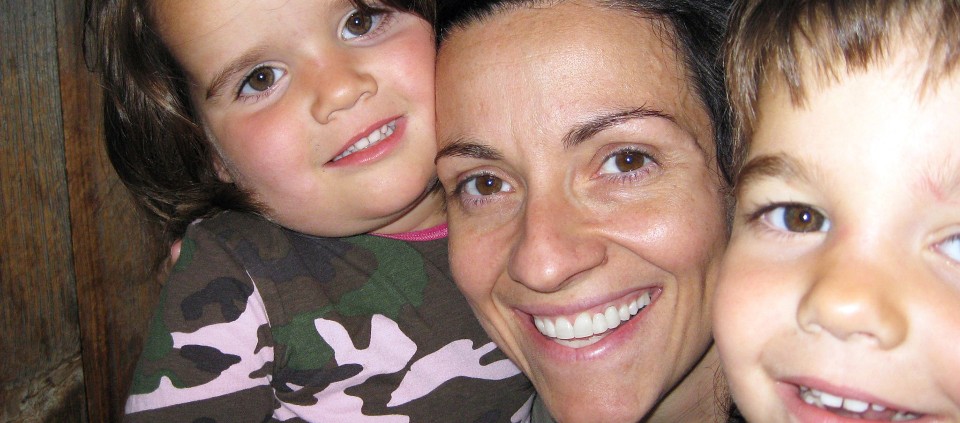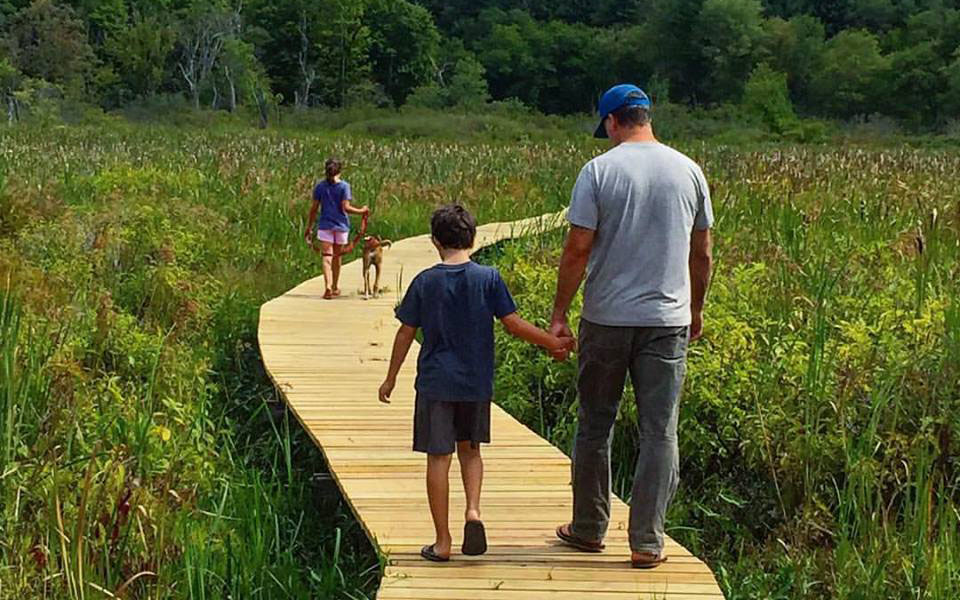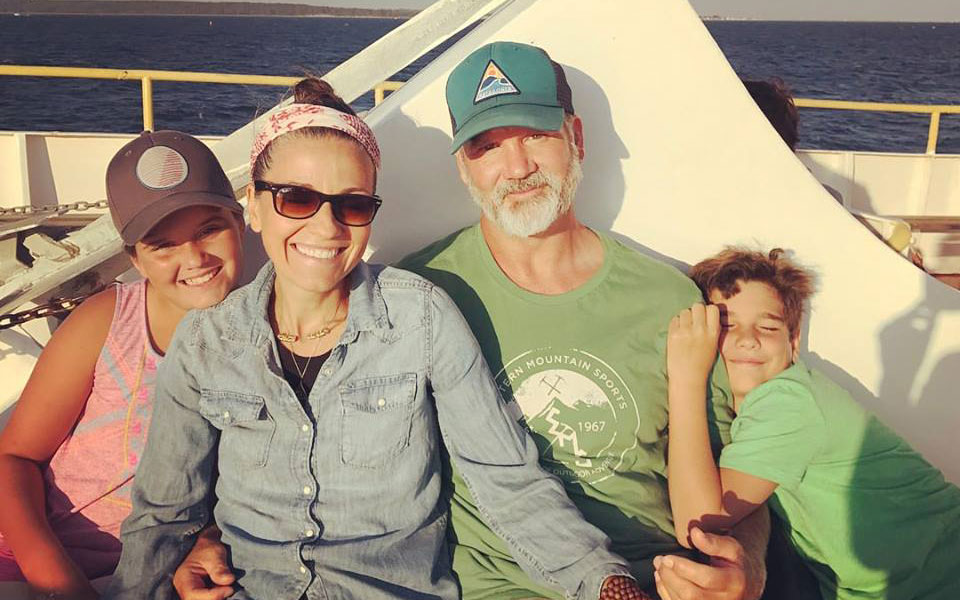Yoga and Parenting: Breath, Self-Care, and Letting Go

by Kimberly Jordan Allen
One of the best lines I ever heard from a mom was, “When I’m with my kids, I’m not myself. And when I’m not with my kids, I’m not myself.” Parenting is the most rewarding learning experience of my life. And it’s not for the faint of heart. Some days, as a mom, I rock. And some days as a mom, I think I am doing it all wrong. So, I apply my practice. But what does it mean to be a mindful parent?
For the first three years, I was home with my twins while my husband worked full-time. By the middle of year three, I was a bit lost. No one had called me by my first name (at least not so I’d notice) in about two years. I was elbow-deep in organic baby snacks, Music Together, and naptime. I wore my yoga clothes every day, but practice was a glimmer on the horizon, having been lost for a year or two as well. This time was magical in so many ways, but with sleep deprivation, I was a bit of a wet noodle.
Being a parent is an endless process of what I call healthy detachment. For the mother and baby, we start in one body. Then birth. Then everyone in one bed. Then baby/babies across the hall. Then about 18 years of hanging out until we detach and let go again. It’s not easy. But it’s the one of the best rides in town.
I have 11-year-old twins now. They are beautiful, bright beings, completely different from one another and with big, beaming hearts. And they have my heart. So how do I ground myself? When we love so much that we’d do anything, how do we hold our own? It’s about letting go, and the real act of letting go is the learning. This took me the last 11 years to grasp. I’m getting it, but it’s a journey.

For me, this journey has been couched in the notion of practice, always. I tend toward perfection, and there’s no such thing when it comes to parenting. But the notion of practice—of applying what I’ve learned, starting each day anew—this is the path. This lets me make mistakes and start over. And yoga, mindfulness, and meditation have taught me a lot about myself and about parenting along the way. These practices carry me. And they grow in value as my awareness and sense of intention deepen.
When my husband, Tim, and I got pregnant, we were thrilled. Pregnancy was a sweet time. The excitement of two little beings growing had us over the moon. It was a bit stressful, as we were expecting twins and had a few scares early on. But we tempered that with a lot of talking to the belly, and deep breaths. We had music sessions to see which side kicked more (“Oh, Baby A definitely prefers '70s music, compared to the punk rock rumblings of Baby B”). In bed, I gingerly turned from one side to the next, like a rotisserie chicken. I worked until 26 weeks, when I was put on bed rest. We waited with anticipation.
The birth by Caesarean was sudden. Afterward, we were in the NICU for a couple of weeks, as one of our babies had a habit of stopping breathing occasionally. When he did that, so did I. Our nurse was calm and patient. She would tickle his feet and give him some oxygen. “Come on, little guy, back to it.” And back he’d come. My tender postpartum heart toiled over this, but I used my breath to quell anxiety and put total faith in the medical team. They knew what they were doing. I could trust this. I had to.
Our first week home, we were so new. We had our co-sleeper ready to go. We had the twins in our bed or right next to us. Close. Attached. We responded to every call, every sound. We snuggled and nested. After a few months of sleep deprivation, we moved them across the hall into a crib, each in their own little snuggle nest. Everyone could sleep better. A bit farther away.
When I went back to work, after three years of freelancing, I dove into learning more about meditation, yoga, and Ayurveda. I learned about the natural rhythms of the day, the seasons, the year, which helped me get my own rhythms, disrupted by sleep deprivation, back on track. I started to get into my body more and understand that my approach to things infused them with meaning. This made me think about my habits, both good and bad. Some of these included staying up too late and not getting enough rest—moving fast in general, without slowing down for self-care and mindfulness. Everything started to become clearer. And I could see how these habits impacted my family.
One of the biggest lessons Ayurveda taught me is that I need sleep. Like, really need it. And so does everyone else. Winding down in the evening became a sweet ritual for all of us. Bath time, dim lights, sweet stories. This quiet space is sacred and something we treasure.
I also learned that I am vata-pitta and need balance and nourishment each day to thrive. And that, if I am feeling harried or overwrought, I have the power to temper this with calm quiet, nurturing through food, breathing practice, and overall attentiveness.
Yoga teaches me that the main undercurrent to all of this is the breath. No matter what happens, each moment I have an opportunity to be in the breath, to close my eyes and notice how I feel. This instantly brings me out of my head (where I tend to loiter) and into my body. And it permeates the family, too. While we were in the NICU, we’d do kangaroo care (skin on skin) and my husband would hold the twins and chant om gently, consistently, for extended periods. A deep, long vibration that soothed and unified all of us. The breath is always what we come back to. After tears, “Take a deep breath.” Ahh, better. Even when I peek in on my littles at night before bed and see the oceanic rise of duvet—ah, breath. Better.
When the kids were toddlers, there was a lot of exploration. And plenty of tantrums. At first, these nutty moments, especially in public, would get to me. I would react. And I never liked who I was in those reactions (my tendency is to be hard on myself). Over time, I learned that the calmer I was, the calmer they were. It’s not always about talking. Connection can be silent. Just allowing space to be, to breathe, to share the silence. This is a reservoir I tap into time and again with my kids. Today, as a mother of tweens, I maintain my personal practice as best I can. There are certain things we do together, to create connection. For us, an easy way to connect is to get outside. Being in nature is a powerful teacher. And as a parent, it’s about trusting, letting go, and allowing them to get dirty, to climb a tree, to fall, and to just be.

Each day, I give myself permission to start again. As I’ve learned to care for myself, I’ve learned that without it, I can’t care for others. This is a big lesson, especially for moms—and dads! It’s not perfect. It doesn’t have to be. We just have to do it. Here are a few tips and wisdom from some of my teachers and friends.
Breathe. It all comes back to the breath. The way that we breathe can influence our entire bodily system and functioning. Studies show that, when we take calm, slow, belly-filling breaths, we send signals to the brain that say, “All okay down here! Proceed calmly!” When we take the time to breathe fully, we can tackle anything the day has to offer. When we don’t, the breath becomes shallow, sending fight-or-flight signals that stimulate the stress response.
Strike a pose. It’s not always easy to fit in exercise, but it can be done, whether it’s a yoga class, a walk, or Pilates. When the twins were little, I’d throw them in a stroller and go. Research finds that exercise can mitigate symptoms of anxiety, working as well or even better than a placebo in certain instances.
Get mindful. I’m an early bird, so I meditate first thing, while the tea/coffee/matcha/golden milk is brewing. Some weeks, I time myself (that helps me to not think about time as I know it’s being tracked) and some weeks I don’t. And I don’t judge. I just sit for as long as I can. I love how Sharon Salzberg describes the benefits of meditation: “Mindfulness meditation remakes our relationship to everything. It helps us experience joy and pleasure fully, without that extra thing we do of trying to keep it from changing. In addition, it helps us experience pain with presence and compassion instead of anger and fear; and helps us experience neutral times differently, so that we are much more connected and aware.”
Turn it off. Technology is imposing. It gets in the way of real connection. There is a time and a place for the phone and there are some places it should never be: on the dining table, when doing something fun with your kids, or in your bed. Unplugging is critical for mental health. Studies are finding that too much time on smartphones is leading to increased anxiety, a stronger sense of isolation, and even addictive tendencies. Kripalu Schools faculty member Coby Kozlowski shares, “When we unplug, it is an opportunity to listen to our inner world, for what is actually wanting our attention, what needs to be tended to, where we are out of alignment.” There is obviously nothing about technology in classical yogic or Ayurvedic texts, but “thankfully the sages of Ayurveda left us wisdom on what it means when we overuse our senses,” says Erin Casperson, Dean of the Kripalu School of Ayurveda, who teaches Ayurveda-inspired tips for staying in control of your relationship with technology.
Connect to your heart. I already talked about meditation, but metta deserves its own mention. I learned about metta meditation at Kripalu, and it shifted my consciousness. This simple act of offering compassionate awareness can literally change your day. I don’t do this all the time, but when it feels right, I practice and offer this sweet translation taught to me by Stephen Cope: “May you feel safe and protected. May you feel contented and pleased. May your body support you with strength. And may your life unfold smoothly and with ease.”
Bring it all into the world. In yogic texts, the yamas and niyamas describe the ethical guidelines of yoga. Ahimsa, the first of the yamas, is nonviolence. In the context of family, practicing nonviolence involves compassionate self-awareness. I can’t act like Mother Teresa at the yoga studio and then get on the highway only to start cursing like a drunken sailor. This is true with kids, too. Early on, I learned that whatever I wanted to see in them, I needed to model. One way I do this is by processing mindfully with my kids. Now that they’re tweens, I hear, “So-and-so said this” or “That hurt my feelings.” The mama bear in me wants to kick some butt, but the compassionate, mindful part of me knows that we can never know what someone else is going through. So, we practice empathy. “Sweetheart, do you think maybe so-and-so was having a bad day?” Or “Maybe so-and-so felt left out when you and the other girls were playing?” The act of imagining what someone else might be feeling allows the kids another perspective and helps them empathize. This is huge, especially in today’s age of tween tech overload and selfie saturation.
Practice, not perfection. Go easy on yourself. And your partner. And your kids. The less you judge, berate, and self-criticize, the more you can accept everyone around you. The idea of “practice, not perfection” gives us space to experiment. We can try. We can do better next time. And we will.
Kimberly Jordan Allen is an award-winning writer, editor, and content strategist. Her work has appeared in Yoga Journal, Shape, and Berkshire Magazine, and has been featured on Sonima and the Huffington Post.
© Kripalu Center for Yoga & Health. All rights reserved. To request permission to reprint, please email editor@kripalu.org.